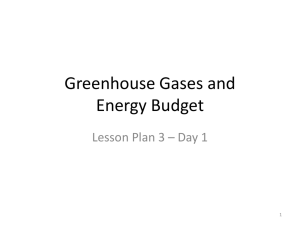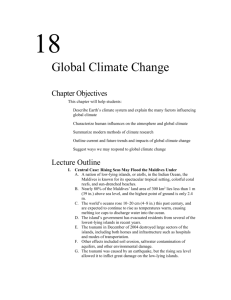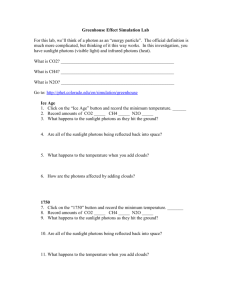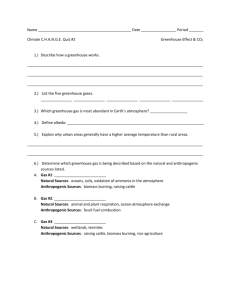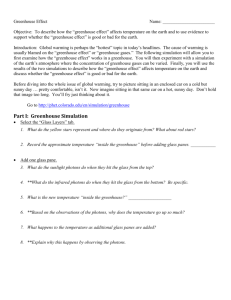Phet_Greenhouse Effect Simulation
advertisement
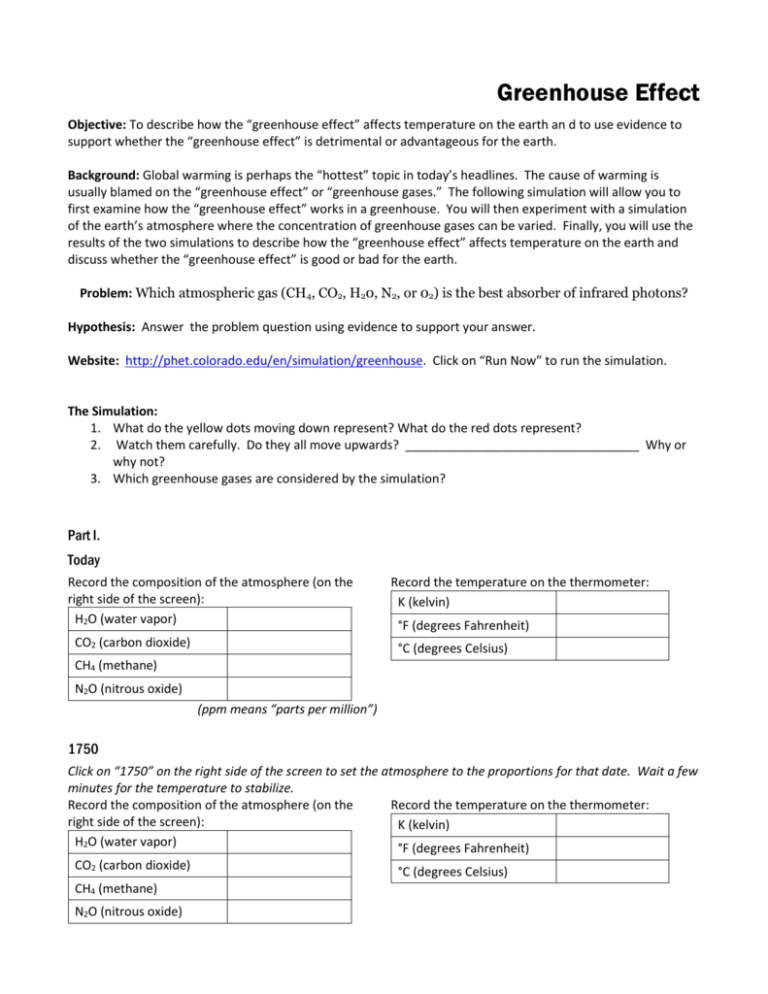
Greenhouse Effect Objective: To describe how the “greenhouse effect” affects temperature on the earth an d to use evidence to support whether the “greenhouse effect” is detrimental or advantageous for the earth. Background: Global warming is perhaps the “hottest” topic in today’s headlines. The cause of warming is usually blamed on the “greenhouse effect” or “greenhouse gases.” The following simulation will allow you to first examine how the “greenhouse effect” works in a greenhouse. You will then experiment with a simulation of the earth’s atmosphere where the concentration of greenhouse gases can be varied. Finally, you will use the results of the two simulations to describe how the “greenhouse effect” affects temperature on the earth and discuss whether the “greenhouse effect” is good or bad for the earth. Problem: Which atmospheric gas (CH4, CO2, H20, N2, or 02) is the best absorber of infrared photons? Hypothesis: Answer the problem question using evidence to support your answer. Website: http://phet.colorado.edu/en/simulation/greenhouse. Click on “Run Now” to run the simulation. The Simulation: 1. What do the yellow dots moving down represent? What do the red dots represent? 2. Watch them carefully. Do they all move upwards? __________________________________ Why or why not? 3. Which greenhouse gases are considered by the simulation? Part I. Today Record the composition of the atmosphere (on the right side of the screen): H2O (water vapor) CO2 (carbon dioxide) Record the temperature on the thermometer: K (kelvin) °F (degrees Fahrenheit) °C (degrees Celsius) CH4 (methane) N2O (nitrous oxide) (ppm means “parts per million”) 1750 Click on “1750” on the right side of the screen to set the atmosphere to the proportions for that date. Wait a few minutes for the temperature to stabilize. Record the composition of the atmosphere (on the Record the temperature on the thermometer: right side of the screen): K (kelvin) H2O (water vapor) °F (degrees Fahrenheit) CO2 (carbon dioxide) CH4 (methane) N2O (nitrous oxide) °C (degrees Celsius) Ice Age Click on “Ice Age” on the right side of the screen to set the atmosphere to the proportions for Earth’s last major ice age. Wait a few minutes for the temperature to stabilize. Record the composition of the atmosphere (on the Record the temperature on the thermometer: right side of the screen): K (kelvin) H2O (water vapor) °F (degrees Fahrenheit) CO2 (carbon dioxide) °C (degrees Celsius) CH4 (methane) N2O (nitrous oxide) Glass Layers Click on the “Glass Layers” tab at the top of the screen. On the right side of the screen, set the Number of Glass Panes to “1”. 4. Watch the yellow photons carefully. Do they pass through the glass or are they blocked? 5. Watch the red photons carefully. Do they pass through the glass or are they blocked? (Move the slider at the bottom of the screen to slow down the animation if necessary.) 6. Record the temperature on the thermometer: __________K, ___________ °F. 7. Your family’s car has been parked outside on a cold but sunny day. When you get in the car, it is much warmer than the air outside. Explain how this can happen. Photon Absorption Click on the “Photon Absorption” tab at the top of the screen.A methane molecule sits in the middle of the screen. Use the slider on the left side of the screen to shoot some infrared photons at the molecule. 8. Do all the photons pass through the molecule? 9. When a photon gets absorbed, what happens next? 10. When a new photon is emitted, is it always sent in the same direction? Use the buttons on the right side of the screen to test different molecules. Record your observations in the table below. Write “yes” if any photons get absorbed; write “no” if no photons get absorbed. Which gases absorb photons? Infrared Photons Visible Photons CH4 (methane) CO2 (carbon dioxide) H2O (water vapor) N2 (nitrogen) O2 (oxygen) 11. Which three gases contribute to the greenhouse effect in our atmosphere? 12. Which two gases do NOT contribute to the greenhouse effect? 13. This computer simulation represents a model of global warming for a simplified Earth. What are some simplifications made by the computer programmers? Could a computer simulation of the Earth ever be 100% accurate? Part 2. Your experiment. Design your own experiment to answer the problem question. Use these hints to help you. Use the adjustable concentration radio button when running your simulation (run it once with no greenhouse gases, then choose where you’d like greenhouse gas concentrations to be) Add clouds Experiment with the number of glass panes. Write out the procedure you took to run your experiment. Create a Data table to illustrate the information you acquired. Answer the following conclusion questions. 14. Is the behavior of the photons more similar to the greenhouse simulation with or without glass panes? 15. How does adding clouds affect the average global temperature? Why? 16. Considering the behavior photons, why does the temperature drop so much when there are no greenhouse gases? 17. Considering the behavior of photons, why does the temperature increase when you add greenhouse gases? 18. How does the greenhouse effect affect temperature on the earth? Is this advantageous or detrimental to our planet? 19. What processes caused an increase in the Earth’s temperature? 20. What are some natural processes that may contribute to global warming? 21. What are some man-made processes that may contribute to global warming? What are some ways to counteract these processes? 22. What recent evidence has been gathered to support the theory of global warming? 23. What is the current political climate regarding global warming? Why has global warming been a controversial theory? Sources: Charles N. Long, et al (2005). Changes in Earth’s Reflectivity. Science 308 (5723). Lesson plans adapted from Phet.colorado.edu.





